In this comprehensive guide, we will explore the characteristics of clematis, how it interacts with trees, optimal growth conditions, and tips for ensuring a harmonious relationship between these beautiful vines and their wooden counterparts.
Understanding Clematis: A Quick Overview
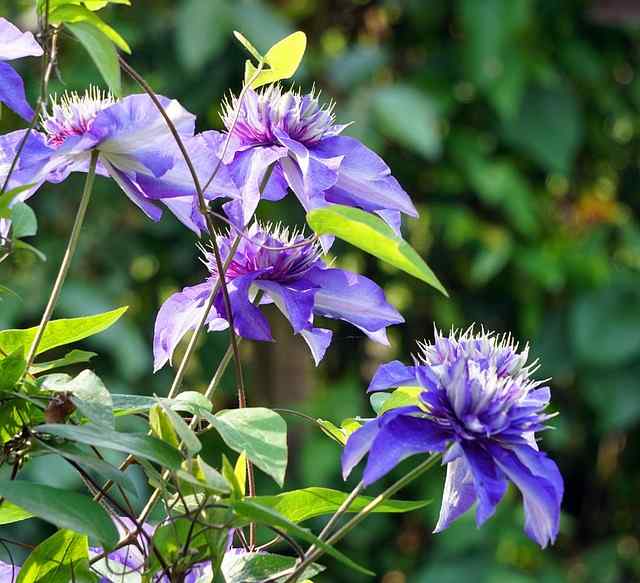
The Nature of Clematis
Clematis, a member of the Ranunculaceae family, is renowned for its diverse range of species and cultivars. The genus comprises around 300 species, each with unique flowering habits and growth attributes. From delicate, pearly white blossoms to vibrant purple and red examples, clematis is celebrated for its versatility in ornamental gardening.
Growth Habit
Clematis is categorized based on its growth habit, which largely influences its climbing potential. Most varieties exhibit climbing tendencies through twining leaf stems or petioles. Some species, such as Clematis montana, are particularly vigorous and can rapidly cover large spaces, including trees. However, not all clematis mounts a successful attack on tree trunks; it entirely depends on the species and environmental factors.
Can Clematis Climb Trees?
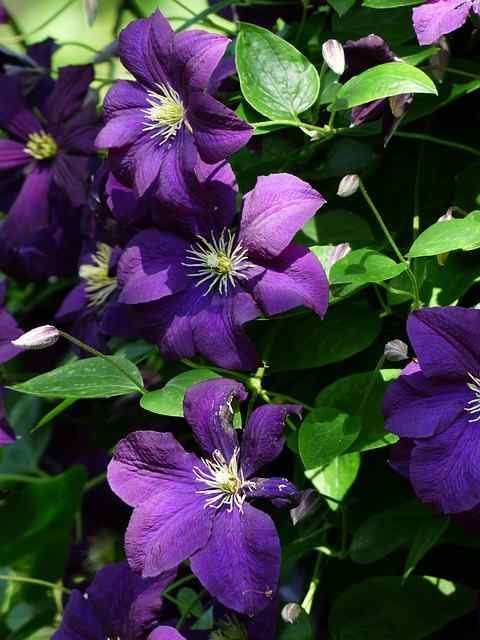
The Mechanics of Climbing
To understand if clematis can successfully ascend a tree, we first need to explore how climbing works in plants. Clematis, as a vine, utilizes its leaves and stem structures to latch onto nearby supports. These structures can wrap around branches or adhere to the tree’s surface using a twisting motion. Unlike other climbing plants that might cling with tendrils or adhesive pads, clematis relies more on its physical ability to reach for sunlight.
Types of Trees Suitable for Clematis
Not all trees are created equal when it comes to hosting clematis. Some trees provide the necessary structure and sunlight, while others may hinder growth due to dense foliage or bark characteristics. Here’s a look at a few tree types that complement clematis growth:
Deciduous Trees: A thriving environment for clematis, as they allow sunlight through in the early days of spring when clematis begins to bloom. The seasonal shedding of leaves provides sufficient light for the plant to thrive.
Sturdy Trees: Trees like oak or maple with strong branches provide a solid anchor for climbing clematis. Their bark texture can be beneficial for the vine to grip.
Ornamental Trees: Flowering or showy trees like magnolias and dogwoods make fantastic companions for clematis, creating a stunning visual display during the blooming season.
Conversely, avoid attempting to grow clematis up conifers or any tree with smooth bark, as these will not support the climbing action properly.
Factors to Consider When Planting Clematis Near Trees

Light and Shade
While clematis enjoys sunlight, it’s essential to balance sunshine and shade. Too much shade from a densely branched tree can prevent the plant from photosynthesizing efficiently, leading to weaker growth and fewer blooms. Try to position the clematis where it can receive morning sun while benefiting from afternoon shade.
Soil Conditions
Clematis prefers well-drained soil rich in organic matter. When planting near a tree, ensure the soil is not overly compacted, as this can occur around tree roots. A loose, fertile environment allows for optimal growth, so consider amending the soil with compost or aged manure before planting.
Watering Needs
Clematis demands consistent moisture but abhors soggy roots. Careful attention to watering is crucial, particularly when growing near trees. Trees often compete for moisture, which can lead to drought stress for your clematis. Pay close attention to weather conditions and adjust your watering accordingly to ensure the plant remains hydrated.
Selecting the Right Clematis Varieties for Climbing
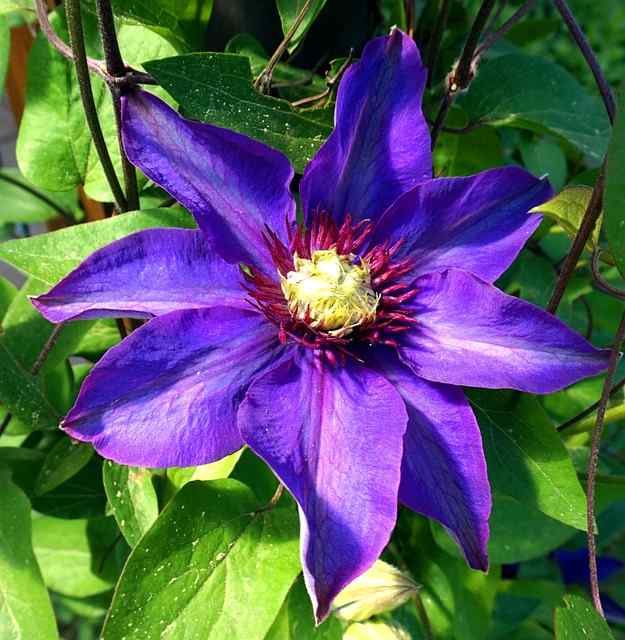
Species Selection
Certain clematis varieties are more adept at climbing trees than others. Here are some notable selections:
Clematis montana: Known for its vigorous growth and breathtaking blooms, Montana is an excellent choice for ascending trees. It can rapidly cover the tree, creating a captivating display.
Clematis viticella: This species offers adaptable growth habits and copious flowering. Its twining growth makes it quite adept at climbing through the branches of trees.
Clematis jackmanii: A favorite among gardeners for its large flowers and ability to climb rapidly. Jackmanii creates a stunning effect when trained on tree limbs.
Clematis ‘Nelly Moser’: This variety blooms in the early summer with a unique floral pattern. It can climb well, although it may require some support in its initial stages.
Each species comes with its unique requirements and characteristics, so be sure to choose a clematis that suits the specific tree and environment.
Training Clematis on Trees
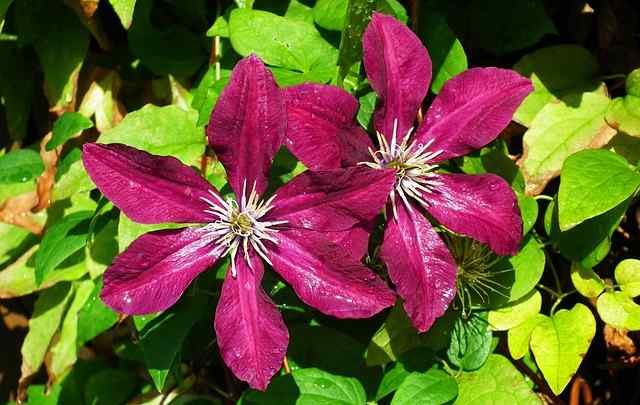
Initial Support
When introducing clematis to a tree, early training is essential to ensure it finds its path upward. You might consider using twine or garden ties to help guide young vines in the right direction. Be gentle and avoid constricting the stems as they grow.
Pruning Techniques
Regular pruning is a crucial aspect of clematis care, particularly if the vine is intertwined with tree branches. Different species have varying pruning requirements:
For Group 1 varieties (early bloomers), prune just after flowering to encourage healthy growth.
For Group 2 (rebloomers), a light pruning in early spring helps to promote better flowering.
For Group 3 (late bloomers), prune in late winter or early spring before new growth begins.
Proper pruning ensures the clematis maintains its vigor and doesn’t overwhelm the tree.
Maintaining Clematis Growth
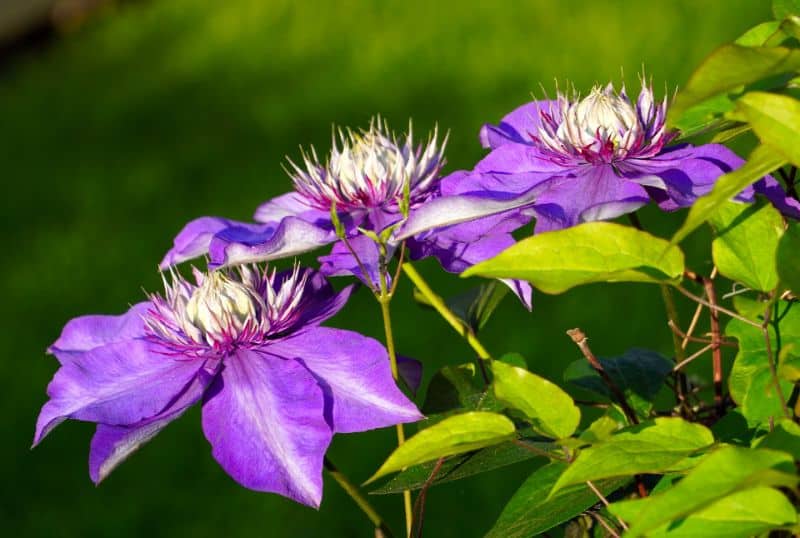
Proper Fertilization
Fertilizing is vital for vigorous growth and flowering. Use a balanced, slow-release fertilizer in early spring to promote healthy development. This stage in development is crucial for ensuring a strong start, particularly when competing with larger trees.
Pest and Disease Control
Clematis can be susceptible to pests like aphids, slugs, or diseases such as wilt. Regular monitoring and prompt action—such as using neem oil or insecticidal soap—can prevent larger infestations. Ensuring good airflow around the plant by clearing out any excess foliage will help keep diseases at bay.
Seasonal Care
As seasons change, adjusting care for the clematis becomes essential. Regular check-ins during winter are vital as some varieties may experience winter dieback. Mulching can protect the roots during colder months, offering insulation against fluctuating temperatures.
Special Considerations When Planting Clematis Around Trees
Competition for Resources
When planting clematis near trees, be mindful of how both plants will compete for available resources. Trees consume significant amounts of water and nutrients, which can negatively affect the growth of nearby plants. Regular monitoring and supplemental feeding can help your clematis thrive despite this competition.
Environmental Adaptability
Different areas have unique soil types, moisture levels, and microclimates. Observing how your particular environment interacts with your tree and clematis will aid in achieving the best growth conditions. Keeping a gardening journal can help with planning and improving care strategies over time.
Companion Planting with Clematis and Trees
Synergistic Relationships
Clematis doesn’t have to live in isolation by climbing trees; it can also be planted with companion plants to enhance overall garden aesthetics and health. Consider low-growing perennials or annuals that thrive in the shade cast by trees, adding layers to your garden’s visual appeal.
Flowering Plants
Consider incorporating shade-tolerant annual flowering plants or foliage plants that can thrive at the base of the tree. They will create a rich tapestry of colors and textures that complement the climbing tendencies of clematis while providing a burst of color below.
The Aesthetic Appeal of Clematis on Trees
Creating a Visual Masterpiece
Clematis climbing trees can create breathtaking displays that transform an ordinary landscape into a living canvas. The splendor of flowers against the backdrop of tree bark and leaves brings depth, dimension, and enchantment.
Seasonal Changes
Another appealing aspect is the seasonal change. As the clematis blooms in the spring and summer, it offers an evolving spectacle, providing interest as it transforms from foliage to abundant flowers, and then back to the husks of winter.
Conclusion: The Perfect Climbing Companion
So, will clematis climb a tree? Absolutely, but with careful planning and consideration. The intertwining of these vines with trees provides stunning beauty and botanical benefits. By choosing the right varieties, providing the necessary support, and ensuring optimal growth conditions, you can create a lovely relationship between clematis and tree.





